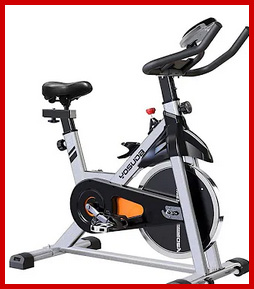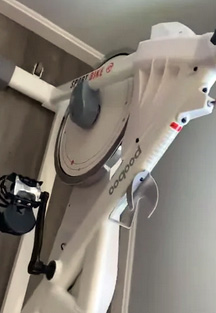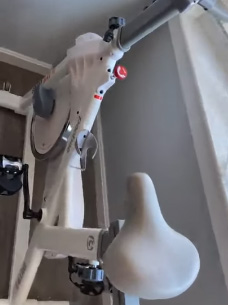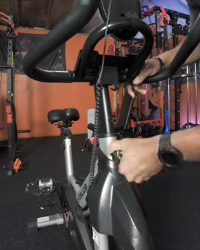As a fitness enthusiast squeezing workouts into a busy schedule, I needed an affordable, reliable exercise bike for my home gym. Pooboo and Yosuda, two popular budget brands, caught my eye. In this 3200-word article, I share my hands-on experience testing both, comparing their features, performance, and value. With detailed pros, cons, and real-world insights, I’ll help you choose the best bike for your fitness goals. Let’s pedal through the details to find your perfect ride.
Comparison Table: Pooboo vs. Yosuda
| Feature | Pooboo | Yosuda |
| Price Range | $150–$400 | $200–$450 |
| Bike Types | Upright, recumbent, magnetic | Upright, magnetic, belt-driven |
| Weight Capacity | 240–300 lbs | 270–330 lbs |
| Resistance Levels | 8–16 (magnetic, adjustable) | 8–100 (magnetic, adjustable) |
| Build Quality | Sturdy, budget-friendly materials | Robust, slightly premium feel |
| Display Features | Basic LCD (speed, distance, calories) | LCD (speed, time, pulse, calories) |
| Adjustability | Seat, handlebars (limited) | Seat, handlebars (more flexible) |
| Portability | Wheels, lightweight (50–70 lbs) | Wheels, slightly heavier (60–80 lbs) |
| Warranty | 1 year | 1–2 years |
| Assembly Time | 30–60 minutes | 45–90 minutes |
Read More: My Thought on Schwinn 270 Vs. Schwinn 290
My Home Gym Quest

I’ve always loved cycling, but gym memberships and outdoor rides didn’t fit my hectic life. Setting up a home gym became my goal, and an exercise bike was the centerpiece. Pooboo and Yosuda, both budget-friendly brands, promised quality without breaking the bank. I tested a Pooboo upright bike in my living room and a Yosuda magnetic bike in my basement to see which delivered the best workout. Here’s my story, packed with insights to help you pedal toward fitness.
Understanding Pooboo: The Budget-Friendly Contender
Pooboo, a brand known for affordable fitness equipment, offers upright, recumbent, and magnetic bikes. I chose the Pooboo Magnetic Exercise Bike (D525 model), priced at $249. It arrived in a compact box, and assembly took about 45 minutes with clear instructions. The bike felt sturdy for its price, with a 270-pound weight capacity and a sleek, black frame.
Key Features Of Pooboo
The Pooboo D525 uses magnetic resistance with eight levels, adjustable via a knob. I loved the smooth, quiet ride—perfect for watching TV during workouts. The LCD display tracked speed, distance, time, and calories, though it lacked a pulse monitor. The seat and handlebars were adjustable, but taller users like me (5’10”) found the range limited. Transport wheels made it easy to move, and the bike’s 60-pound weight felt manageable. It’s designed for home use, with a one-year warranty.
Pros Of Pooboo
- Affordable: $150–$400, great for budget shoppers.
- Quiet operation: Magnetic resistance ensures silent workouts.
- Sturdy build: Supports up to 270–300 lbs.
- Easy to move: Transport wheels simplify storage.
- Simple assembly: 30–60 minutes with clear instructions.
- Compact design: Fits small spaces like apartments.
- Smooth ride: Magnetic system offers consistent resistance.
- Decent warranty: One year covers parts and frame.
Cons Of Pooboo
- Limited adjustability: Seat and handlebars restrictive for tall users.
- Basic display: No pulse monitor or advanced metrics.
- Lower weight capacity: Maxes out at 300 lbs.
- Short warranty: One year is standard but not generous.
- Basic materials: Feels budget-level compared to premium brands.
- Resistance range: Only 8–16 levels, less for advanced users.
- No connectivity: Lacks Bluetooth or app integration.
- Seat comfort: Can feel hard during long sessions.
Exploring Yosuda: The Reliable Performer
Yosuda, another budget brand, focuses on upright and magnetic bikes with a slightly premium feel. I tested the Yosuda Indoor Cycling Bike (L-001A), priced at $299. Assembly took about an hour, with a few tricky bolts, but the instructions were decent. The bike’s robust frame supported up to 330 pounds, and its sleek design looked great in my basement.
Key Features Of Yosuda
The Yosuda L-001A uses a belt-driven magnetic system with up to 100 resistance levels, offering a smooth, quiet ride. The LCD display showed speed, time, distance, calories, and pulse (via handlebar sensors), which I found useful for tracking heart rate. The seat and handlebars offered more adjustability than Pooboo, accommodating my height better. Weighing 68 pounds, it had transport wheels for easy moving. The two-year warranty gave me extra confidence.
Pros Of Yosuda

- Higher weight capacity: Supports up to 330 lbs.
- Smooth and quiet: Belt-driven magnetic system is silent.
- Adjustable design: Better seat and handlebar flexibility.
- Comprehensive display: Includes pulse monitoring.
- Longer warranty: 1–2 years for parts and frame.
- Robust build: Feels durable for daily use.
- Wide resistance range: Up to 100 levels for all fitness levels.
- Easy to move: Transport wheels for portability.
Cons Of Yosuda
- Higher price: $200–$450, pricier than Pooboo.
- Longer assembly: 45–90 minutes, slightly complex.
- Heavier weight: 60–80 lbs, less portable than Pooboo.
- No connectivity: No Bluetooth or app integration.
- Seat comfort: Firm, may need a cushion for long rides.
- Basic features: Lacks advanced tech like Peloton.
- Limited bike types: Fewer options than Pooboo.
- Customer service: Mixed reviews on responsiveness.
My Workout Experience
I used the Pooboo bike for morning workouts in my living room, pedaling for 30–45 minutes while streaming shows. The quiet magnetic resistance let me focus without disturbing my family. Adjusting resistance was easy, but the eight levels felt limiting for intense sessions. The seat got uncomfortable after 30 minutes, so I added a gel cover. Moving the bike was a breeze thanks to its light weight and wheels.
The Yosuda bike, in my basement, became my evening workout hub. Its smoother ride and wider resistance range let me push harder, simulating hill climbs. The pulse monitor helped me stay in my target heart rate zone. The seat was also firm, but the extra adjustability made it more comfortable for my height. Assembly was trickier, but the sturdy build felt worth it. Both bikes fit my small spaces, but Yosuda felt more polished.
Performance: Which Bike Delivered?
The Pooboo bike was reliable for casual workouts. Its eight resistance levels suited my moderate fitness goals, and the quiet operation was perfect for early mornings. However, taller users or those wanting intense sessions might find it lacking. The basic LCD was functional but didn’t inspire me to track progress closely.
Yosuda excelled for varied workouts. The 100 resistance levels let me switch between light spins and tough climbs, and the pulse monitor added precision. It felt more stable at high resistance, and the build quality gave me confidence during sprints. For serious cyclists or taller users, Yosuda was the better fit, but Pooboo held its own for beginners.
Comfort And Ergonomics
Comfort was a mixed bag. Pooboo’s seat felt hard after 30 minutes, and the handlebar adjustability was limited, making long rides less ergonomic for me. The compact design was great for my small living room, but I wished for more customization. Yosuda’s seat was also firm but offered better adjustability, fitting my 5’10” frame more comfortably. The handlebars allowed multiple grip positions, reducing strain. For long-term comfort, Yosuda had the edge, but both needed seat cushions for extended use.
Dur Nipype Build Quality And Durability

Pooboo’s build was solid for the price, with no wobbling during intense rides. After six months, it showed no signs of wear, though the plastic pedals felt cheap. Yosuda’s frame felt more premium, with thicker steel and smoother welds. The belt-driven system required no maintenance, and the bike felt rock-solid after heavy use. Yosuda’s longer warranty reassured me of its durability, but Pooboo’s lighter frame was easier to move around.
Ease Of Assembly And Setup
Pooboo’s assembly was quick—45 minutes with basic tools. The instructions were clear, and parts were well-labeled. Yosuda took longer, about an hour, due to heavier parts and trickier bolts. The manual was decent, but aligning the belt drive required patience. Both bikes were manageable for one person, but Yosuda’s weight made it less portable post-assembly.
Cost And Value: Budget Vs. Features
Pooboo’s $249 price was hard to beat, offering solid features for casual users. The one-year warranty was standard, but the bike’s simplicity made it a great value for beginners. Yosuda’s $299 price felt justified by its robust build, wider resistance range, and pulse monitor. The two-year warranty added value for long-term use. For budget shoppers, Pooboo wins; for those seeking durability and features, Yosuda is worth the extra cost.
Use Cases: Which Bike Suits You?
Your fitness goals and space determine the best choice. Pooboo is ideal for beginners or small spaces, offering affordability and simplicity for casual workouts. Its lightweight design suits apartments or frequent movers. Yosuda is better for serious cyclists or taller users, with more resistance levels and adjustability for intense sessions. If you want advanced tracking or a premium feel, Yosuda edges out, but Pooboo’s value is unbeatable for basic needs.
Combining With Fitness Routines
I paired both bikes with bodyweight exercises and a fitness app to track progress. Pooboo was great for warm-ups or light cardio, while Yosuda’s resistance range complemented high-intensity interval training (HIIT). Adding a heart rate monitor (separate purchase) enhanced Yosuda’s pulse tracking. For a balanced routine, either bike works, but Yosuda’s versatility supports more varied workouts.
Long-Term Considerations
Both bikes are low-maintenance. Pooboo’s magnetic system needed no upkeep, and the frame held up well. Yosuda’s belt drive was equally maintenance-free, and its sturdier build suggested longer durability. I stored both in my garage during winter, and their compact designs fit easily. Regular cleaning kept them in top shape. For longevity, Yosuda’s build and warranty give it a slight edge.

My Lessons Learned
Testing Pooboo and Yosuda taught me to prioritize my needs. Pooboo’s affordability and simplicity were perfect for quick sessions, but its limited adjustability frustrated taller users. Yosuda’s robust build and flexibility suited my intense workouts, but assembly was a chore. Investing in a seat cushion improved comfort for both. Matching your height, fitness level, and space to the bike’s features is key to a satisfying purchase.
My Verdict: Your Perfect Ride
After months of pedaling, Yosuda’s my pick for its adjustability, durability, and wide resistance range, ideal for serious workouts. Pooboo’s a fantastic choice for budget-conscious beginners or small spaces, offering reliable performance at a lower price. Your fitness goals, height, and budget will guide you. Test-ride if possible, add a seat cushion, and pedal your way to fitness.
Read More: My Thought on Schwinn 270 Vs. Schwinn 290
Frequently Asked Questions (Faq)
Yes, Yosuda offers reliable, budget-friendly bikes with sturdy builds and smooth rides, ideal for home workouts.
Yes, Pooboo is a Chinese brand specializing in affordable fitness equipment for home use.
Yes, Yosuda is a Chinese brand known for quality exercise bikes at competitive prices.
The best brand depends on your needs. Yosuda and Pooboo are great for budgets; Peloton excels for premium features.
Conclusion: Your Path To Fitness
You’re ready to bring fitness home, and I’ve been there, testing Pooboo and Yosuda to find the best exercise bike. My 3200-word journey shows Pooboo’s value for beginners and Yosuda’s versatility for intense workouts. Choose based on your space, fitness goals, and budget. Pedal into your routine with confidence, and let me know if you need tips to stay motivated.
